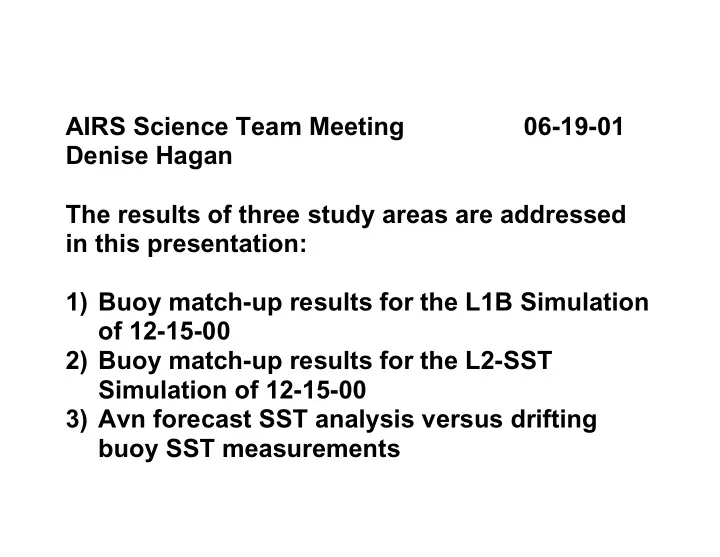

AIRS Science Team Meeting 06-19-01 Denise Hagan The results of three study areas are addressed in this presentation: 1) Buoy match-up results for the L1B Simulation of 12-15-00 2) Buoy match-up results for the L2-SST Simulation of 12-15-00 3) Avn forecast SST analysis versus drifting buoy SST measurements
One technique for L1B Earth Scene IR Validation compares surface marine measurements with AIRS radiance observations in the window channels, especially the super "transparent" 4 µ µ m µ µ Near surface synoptic surface marine data and NCEP sea surface temperature (SST) analysis data are acquired in clear sky regions Coarse corrections are applied to the L1B radiances to account for atmospheric transmission and surface emissivity The TOA L1B brightness temperatures adjusted to the surface are compared with the SST ’truth’ data
Drifting Buoy Match-ups with L1B BT Drifting buoy data were acquired in tropical/semi-tropical regions of the world ocean for AIRS simulation 12-15-00 Only buoy data that varied no more than + 0.1 K during a 24 hour period were utilized in the match-ups. This was done to avoid solar heating effects not presently modeled in the simulated data set A spatial criteria of + 50 km was used for the match-ups The buoy match-ups shown in Figure 1 have reasonable global coverage, except for the South Atlantic/North-East Atlantic, Eastern North Pacific and Indian Oceans. The
locations of drifter nighttime (green) and daytime (red) match- ups in clear sky conditions are shown on the following map. About 40 buoys were matched up with L1B radiances in the clear sky regions. Many AIRS footprints could be matched to a single buoy observation. Number of PGE matchups: 245 AIRS suite L1B/L2 profiles (PGE restricted to +/-50 km; +/- 2 hours); 377 matches if more than one buoy per AMSU/AIRS suite
A home brew split window method was used to identify clouds for both day and night based on threshold criteria: υ > median (BT 911cm-1 minus BT 1251cm-1 ) and υ 1 st Filter if BT υ υ 2 nd Filter if BT_ filtered 1126cm-1 > median (BT_filtered 1126cm-1 ) This split window cloud detection routine favors warm regions in the granule Very coarse transmission and surface emission corrections were applied to the TOA BT. These were derived from Strow RTE calculations for a tropical atmosphere. The SST ’truth’ are compared with TOA BT at 2616 cm -1 and 938 cm -1 . These results are shown in the following Figures 2 and 3. For 2616 cm -1 , the difference between buoy and adjusted radiances is about + 0.5 K; for 938 cm -1 , the difference is about + 1 K
Drifting Buoy match-ups with Simulated L2-SST This analysis focused on a few densely populated granules with large zonal gradients Generally, the L2-SST are cooler than buoy, as shown in Figure 4 Large outliers are present that are related to cloud effects Daily comparisons with buoys in all sky conditions will produce robust statistics, but we will need at least one week of observations (or longer) to generate good statistics for clear sky comparisons
Avn forecast SST analysis versus drifting buoy The differences between buoy and Avn-SST for the bulk latitudes (night match-ups only) are shown in Figure 5 The buoy minus Avn-SST shown in Figure 6 are within + 0.5 K and near-Gaussian in distribution (not unexpected since Avn- SST is tied down at truth points) A slight skewing can be seen towards warmer Avn-SST
Further work is needed to: Eliminate drifter data redundancy (ok for L1B cloud variability detection) Increase ’clear’ match-up yield for day-time (include diurnal gradient corrected to surface) Improve atmospheric correction/cloud detection Compare Reynolds-Smith, Navy and RTG-SST analyses Compare Avn-SST and drifter day-time match-ups (to include surface temperature gradient effects)
Recommend
More recommend